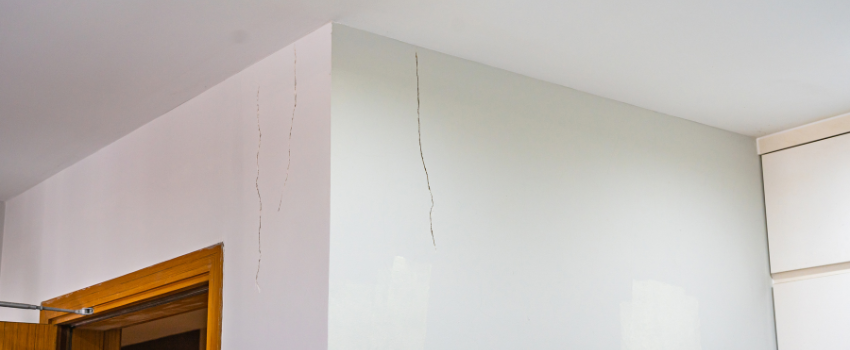Few things are as concerning for a building owner as the sight of cracks in the walls, floors, or foundation. Building cracks not only raise aesthetic concerns but can also be signs of more serious issues. In this guide, the foundation repair experts at URETEK Gulf Coast explore the causes, types, and solutions for common building cracks.
Causes of Cracks in Buildings
Building cracks can be a property owner’s nightmare, but they rarely appear without reason. Various factors can cause them, ranging from natural environmental forces to structural and construction-related issues.
1. Structural Factors
- Foundation Settlement and Subsidence: We start with one of the most common culprits – foundation issues. Settlement and subsidence can lead to cracks as the ground beneath your building shifts over time.
- Overloading or Improper Structural Design: Buildings are designed to carry specific loads. Overloading or design flaws can strain the structure, resulting in cracks.
2. Environmental Factors
- Freeze-Thaw Cycles: In regions with fluctuating temperatures, freeze-thaw cycles can wreak havoc. Water seeping into cracks expands when it freezes, widening existing gaps.
- Soil Moisture Changes: The moisture content in the soil beneath your building can fluctuate due to weather conditions or poor drainage, exerting pressure on the structure.
3. Construction and Material Issues
- Poor Construction Practices: Shoddy workmanship during construction, such as inadequate reinforcement or curing, can result in cracks down the line.
- Low-Quality Materials: Using subpar building materials can increase the susceptibility of your structure to cracking.
Types of Building Cracks: Structural vs Non-Structural
Not all building cracks are the same. Understanding the distinction between non-structural and structural cracks, which can signify serious underlying issues, is crucial for effective building maintenance and safety.
Non-Structural Cracks
- Surface Cracks: Superficial cracks that don’t penetrate deeply into the structure. They are often cosmetic but can indicate underlying issues.
- Hairline Cracks: Extremely narrow cracks that are challenging to spot but may still signify structural concerns.
- Settlement Cracks: These occur due to minor settling and are usually non-threatening. However, they should be monitored.
Structural Cracks
- Vertical Cracks: These often indicate settling, and their width and location can provide insights into the root cause.
- Horizontal Cracks: Typically, horizontal cracks suggest structural stress. They may demand immediate attention.
- Diagonal Cracks: Diagonal cracks can signify a combination of factors, including foundation movement and structural load issues.
Cracks in buildings can be more than just cosmetic annoyances; they can indicate underlying structural problems. Addressing them promptly, with the appropriate solutions, is essential for the safety and longevity of your structure.
Solutions for Cracks in Buildings
Addressing building cracks is a vital step in ensuring the structural integrity and longevity of a foundation. Fortunately, there are several practical solutions available, ranging from preventive measures and repairs to ongoing maintenance, each tailored to specific types and severities of cracks.
Preventive Measures
- Proper Site Preparation: Adequate site preparation, including foundation soil analysis and compaction, can prevent future settlement-related cracks.
- Adequate Drainage Systems: Effective drainage systems help control soil moisture, reducing the risk of cracks caused by water-related issues.
- Quality Construction Practices: Hiring experienced contractors and using quality materials during construction can prevent many structural issues.
Repair and Remediation
- Filling and Sealing Cracks: Minor cracks can often be repaired with epoxy injections or sealants, preventing them from worsening.
- Underpinning and Foundation Repair: For severe structural issues, underpinning and industrial foundation repair may be necessary to stabilize the building.
- Structural Reinforcement: In cases of structural compromise, reinforcing the affected area can restore integrity.
Maintenance
- Regular Inspections: Routine foundation inspections can catch cracks in their early stages, allowing for timely repairs.
- Timely Repairs: Don’t procrastinate when repairs are needed. Prompt action can prevent minor issues from escalating.
When to Seek Professional Help
Recognizing when to hire a foundation repair company for cracks in buildings is crucial for your building’s safety and integrity. While minor, non-structural cracks may be manageable with DIY repairs or cosmetic touch-ups, signs of structural compromise should never be ignored. In these cases, building owners need the expertise of structural engineers or foundation repair specialists who can conduct thorough assessments and carry out long-lasting repairs.
At URETEK Gulf Coast, we encourage you to take a proactive approach, and remember that our experts are here to assist you every step of the way. Don’t let those cracks undermine your peace of mind – take action today.
Contact us to set up a consultation for Houston foundation repair.


